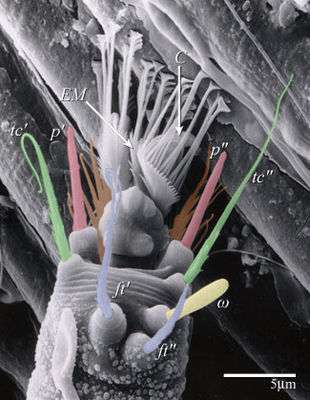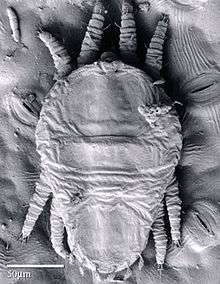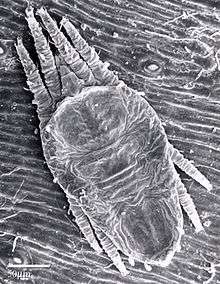Brevipalpus phoenicis
Brevipalpus phoenicis, also known as the false spider mite, red and black flat mite,[1] and in Australia as the passionvine mite,[2] is a species of mite in the family Tenuipalpidae.[2][3][4] This species occurs globally, and is a serious pest to such crops as citrus, tea, papaya, guava and coffee, and can heavily damage numerous other crops.[1] They are unique in having haploid females[5], a condition caused by a bacterium that change haploid males into females.[6]
| Brevipalpus phoenicis | |
|---|---|
 | |
| Scientific classification | |
| Kingdom: | |
| Phylum: | |
| Class: | |
| Subclass: | |
| Order: | |
| Family: | |
| Genus: | |
| Species: | B. phoenicis |
| Binomial name | |
| Brevipalpus phoenicis (Geijskes, 1936) | |
| Synonyms | |
|
Tenuipalpus phoenicis | |
Description
Adults
Adult specimens can grow to 280 μm (0.011 in) long (including the rostrum) and 150 μm (0.0059 in) wide. They are flat, oval, and have a dark green to red-orange colour.[1] The adult males are more wedge-shaped than females. This species has two pairs of legs that extend forward and two extending back. It has two sensory rods on tarsus II that distinguish it from another mite species that is known to occur on the same plants, the privet mite, (Brevipalpus obovatus Donn.).[2] A black, "H"-shaped mark occurs on females when raised in temperatures of 68 °F to 77 °F, although this marking is not present at 86 °F.[2]
- Tarsus

.jpg)
Larvae
Larvae are about 140 μm (0.0055 in) long, have six legs, and are bright orange-red when newly emerged, later becoming opaque-orange.[2] The protonymphs and deutonymphs are somewhat transparent, with some of their inner organs appearing a diffuse green colour, with black or yellow patches. Like the adults, they are eight-legged.[1]
Eggs
Eggs can be seen with the unaided eye, as clusters of reddish-orange.[1]
Distribution
Brevipalpus phoenicis occurs globally, mostly in the tropics.[1] It is known to occur in:
United States
This species has become established in numerous southern states, throughout the mainland from Florida to California, and also in Hawaii.[2]
Life cycle



Brevipalpus phoenicis lays approximately 50 to 60 eggs during adulthood. These eggs have a fragile stipe that projects from them, and may break if handled.[2] The eggs hatch 8 to 16 days after being laid.[1]
Females deposit eggs singly, commonly sharing a single location with other females. Usually 4 to 8 clusters of eggs are present, normally deposited in cracks or the hollow cavities in leaves created when the internal mesophyll has been destroyed.[1] One day before the eggs hatch, they turn opaque white and the red eyes of the larvae within become visible.[1]
In warm to temperate regions, 4 to 6 generations of this mite can occur each year. In tropical regions, at least 10 generations can occur. Ideal conditions for this species are a temperature range of 25–30 °C (77–86 °F) with high relative humidity.[1]
Adult females live for a maximum of 5 to 6 weeks. The maximum life expectancy for this species is 47 days at 68 °F, with a minimum of 7.5 days at 86 °F in regions of relative humidity of 85% to 90%.[2]
Populations of Brevipalpus phoenicis are almost entirely female. This is because the species is parthenogenetic, with most reproduction occurring from unfertilized eggs that produce only females.[1][3] Development takes place in three stages—larva, protonymph, and deutonymph. The maturation from egg to adult occurs during 12 to 24 days.[1]
Hosts
This species is known to have at least 65 hosts, and the USDA reports that there may be up to 1,000. In the state of Florida, this mite is known to infest Aphelandra, gardenia, grapefruit, hibiscus, holly, ligustrum, lemon, lime, orange, pecan and viburnum.[2]
Damage
This species damages fruit by injecting the cells with toxic saliva. They do this to be able to digest the contents. They puncture numerous cells in close proximity to one another, causing visible chlorotic spots around the area. Later, these spots merge to become brown patches. This can stop the plant's growth and result in deformations. This may cause the skin of the fruit to rupture, and shoots to lose leaves and occasionally die back.[1]
On papaya, the mites begin by feeding on the trunk of the tree. As the population becomes more dense, they migrate to the leaves and fruit. Characteristic evidence of feeding sites is drying of the surrounding areas, with brown colour appearing and the area becoming callous and suberized.[1]
Damage to citrus is more severe. When cholorotic spots are great in number, production of the host plants may be severely reduced. Characteristic galls at the nodes may be observed, and the buds may be unable to sprout. Shoots may be grossly misshapen, and very few leaves may develop. This can result in the death of the entire tree.[1]
Apart from the physical damage this species can cause, it is also a vector of both citrus leprosis and the coffee ringspot virus.[1]
Control
Early in the 20th century, Florida farmers used sulfur as a way to control this pest. However, this is toxic to other, beneficial arthropods.[2]
There are at least four natural predators of this species, but are generally not useful economically, as they attack Brevipalpus phoenicis only after the population has increased to very high numbers and severe crop damage has already been done.[2]
Currently, as there is no alternative available, pesticides are used.[2]
See also
Notes
- "Brevipalpus phoenicis - Bayer CropScience Crop Compendium". Compendium.bayercropscience.com. Archived from the original on 2011-12-31. Retrieved 2012-07-24.
- H.A. Denmark & Thomas R. Fasulo (December 2009) [July 2006]. "a false spider mite - Brevipalpus phoenicis (Geijskes)". University of Florida Entomology and Nematology Department. Retrieved 2012-07-24.
- Jayma L. Martin Kessing & Ronald F.L. Mau (1992). "Brevipalpus phoenicis (Geijskes); Red and Black Flat Mite". Crop Knowledge Master. University of Hawaii, College of Tropical Agriculture and Human Resources, and Hawaii Department of Agriculture. Retrieved 2012-07-22.
- Reis, P. R.; Teodoro, A. V. (August 2006). "Brazilian Journal of Biology - Reproductive performance of the mite Brevipalpus phoenicis (Geijskes, 1939) on citrus and coffee, using life table parameters". Brazilian Journal of Biology. 66 (3): 899–905. doi:10.1590/S1519-69842006000500016.
- Brevipalpus mites (Acari: Tenuipalpidae) - Core
- Single mite female | Nature
References
- Bayer Cropscience. "Crop Compendium: Brevipalpus phoenicis". Bayer Cropscience. Archived from the original on 2011-12-31. Retrieved 2012-07-24.
- Chagas, C.M. (1973). "A associacao do ácaro /Brevipalpus phoenicis/ (Geijskes) à mancha anular do cafeeiro". O Biológico (in Portuguese). 39 (9): 229–232.
- Chagas, C.M.; E.W. Kitajima; J.C.V. Rodrigues (2003). "Coffee Ringspot Virus Vectored by Brevipalpus phoenicis (Acari: Tenuipalpidae) in Coffee". Experimental and Applied Acarology. 30 (1–3): 203–213. doi:10.1023/B:APPA.0000006549.87310.41. (subscription required)
- Chiavegato, L. G.; P. R. Kharfan (1993). "Behaviour of the leprosis mite Brevipalpus phoenicis G. (Acari: Tenuipalpidae) on Citrus" [Comportamento do ácaro da leprose Brevipalpus phoenicis G. (Acari: Tenuipalpidae) em citros]. Anais da Sociedade Entomológica do Brasil. 22 (2): 355–359. ISSN 0301-8059. 19941102423. (subscription required)
- Childers, Carl C.; J. Victor French; Jose Carlos V. Rodrigues (2003). "Brevipalpus californicus, B. obovatus, B. phoenicis, and B. lewisi (Acari: Tenuipalpidae): a Review of their Biology, Feeding Injury and Economic Importance". Experimental and Applied Acarology. 30 (1–3): 5–28. doi:10.1023/B:APPA.0000006543.34042.b4. (subscription required)
- Denmark, H. A.; T.R. Fasulo (2009). "A false spider mite: Brevipalpus phoenicis (Geijskes)". University of Florida. Retrieved 2012-07-24.
- Groot, Thomas V. M.; Johannes A. J. Breeuwer (2006). "Cardinium symbionts induce haploid thelytoky in most clones of three closely related Brevipalpus species". Experimental and Applied Acarology. 39 (3–4): 257–271. doi:10.1007/s10493-006-9019-0. PMID 16900311. (subscription required)
- Groot, Thomas V.M.; Arne Janssen; Angelo Pallini; Johannes A.J. Breeuwer (2005). "Adaptation in the Asexual False Spider Mite Brevipalpus phoenicis: Evidence for Frozen Niche Variation". Experimental and Applied Acarology. 36 (3): 165–176. doi:10.1007/s10493-005-3360-6. PMID 16132731. (subscription required)
- Haramoto, F. H. (1969). "Biology and control of Brevipalpus phoenicis (Geijskes) (Acarina: Tenuipalpidae)". Technical Bulletin, Hawaii Agricultural Experiment Station (68): 63. 19740512735. Archived from the original on 2013-04-14.(subscription required)
- Joly Campos, Fernando; Celso Omoto (2002). "Resistance to hexythiazox in Brevipalpus phoenicis (Acari: Tenuipalpidae) from Brazilian citrus". Experimental and Applied Acarology. 26 (3–4): 243–251. doi:10.1023/A:1021103209193. PMID 12537296. (subscription required)
- Kennedy, Dr J. S.; G. Van Impe; Th. Hance; Ph. Lebrun (January–December 1996). "Demecology of the false spider mite, Brevipalpus phoenicis (Geijskes) (Acari, Tenuipalpidae)". Journal of Applied Entomology. 120 (1–5): 493–499. doi:10.1111/j.1439-0418.1996.tb01641.x. (subscription required)
- Kessing, Jayma L. Martin; Ronald F.L. Mau. "Crop Knowledge Master: Brevipalpus phoenicis (Geijskes)". Honolulu, Hawaii: University of Hawaii, College of Tropical Agriculture and Human Resources, and Hawaii Department of Agriculture. Retrieved 2012-07-24.
- Kitajima, E.W.; J.A.M. Rezende; J.C.V. Rodrigues (2003). "Passion Fruit Green Spot Virus Vectored by Brevipalpus phoenicis (Acari: Tenuipalpidae) on Passion Fruit in Brazil". Experimental and Applied Acarology. 30 (1–3): 225–231. doi:10.1023/B:APPA.0000006551.74604.84. (subscription required)
- Kitajima, E. W.; Rezende, J. A. M.; Rodrigues, J. C. V.; Chiavegato, L. G.; Piza Júnior, C. T.; Morozini, W. (1997). "Green spot of passion fruit, a possible viral disease associated with infestation by the mite Brevipalpus phoenicis". Fitopatologia Brasileira. 22 (4): 555–559. ISSN 0100-4158. 19981002743. (subscription required)
- Knorr, L. C.; H. A. Denmark (15 December 1970). "Injury to Citrus by the Mite Brevipalpus phoenicis". Journal of Economic Entomology. 63 (6): 1996–1998. doi:10.1093/jee/63.6.1996. (subscription required)
- Lal, L. (1979). "Biology of Brevipalpus phoenicis (Geijskes) (Tenuipalpidae: Acarina)". Acarologia. 20 (1): 97–101. ISSN 0044-586X. PMID 474063. 19790565293. (subscription required)
- Oomen, P. A. (1982). "Studies on population dynamics of the scarlet mite, Brevipalpus phoenicis, a pest of tea in Indonesia". Mededelingen Landbouwhogeschool (82–01). Wageningen: 89. 160137. Cite journal requires
|journal=(help) - Rodrigues, J.C.V.; M. Gallo-meagher; R. Ochoa; C.C. Childers; B.J. Adams (2004). "Mitochondrial DNA and RAPD polymorphisms in the haploid mite Brevipalpus phoenicis (Acari: Tenuipalpidae)". Experimental and Applied Acarology. 34 (3–4): 275–290. doi:10.1023/B:APPA.0000049221.06269.29. (subscription required)
- Rodrigues, J. C. V.; M. A. Machado; E. W. Kitajima; G. W. Müller (2000). "Transmission of Citrus Leprosis Virus by Brevipalpus phoenicis (Acari: Tenuipalpidae)" (PDF). Fourteenth IOCV Conference, 2000—Other Viruses. pp. 174–178. Retrieved 2012-07-24.
- Teodoro, A. V.; P. R. Reis (August 2006). "Reproductive performance of the mite Brevipalpus phoenicis (Geijskes, 1939) on citrus and coffee, using life table parameters" [Desempenho reprodutivo do ácaro Brevipalpus phoenicis (Geijskes, 1939) em citros e em cafeeiro, utilizando parâmetros de tabela de vida]. Brazilian Journal of Biology. 66 (3): 899–905. doi:10.1590/S1519-69842006000500016. ISSN 1519-6984.
- Weeks, Andrew R.; Frantisek Marec; Johannes A. J. Breeuwer (29 June 2001). "A Mite Species That Consists Entirely of Haploid Females". Science. 292 (5526): 2479–2482. doi:10.1126/science.1060411. PMID 11431565. (subscription required)
- Welbourn, W. Calvin; Ronald Ochoa; Ethan C. Kane; Eric F. Erbe (2003). "Morphological Observations on Brevipalpus phoenicis (Acari: Tenuipalpidae) Including Comparisons with B. californicus and B. obovatus". Experimental and Applied Acarology. 30 (1–3): 107–133. doi:10.1023/B:APPA.0000006545.40017.a0. (subscription required)
External links

